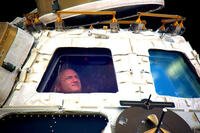Troubling findings into a devastating military training accident that killed nine troops prompted a meeting between the top Navy and Marine Corps leaders to discuss improvements needed to make future naval operations safer.
Eight Marines and one sailor were killed in July when their amphibious assault vehicle filled with water and sank off the coast of California. The investigation into the accident found a series of failures, including communication breakdowns between Navy personnel aboard an amphibious ship and the Marines training on a beach.
Those breakdowns left several decades-old and mechanically unsound Marine amphibious assault vehicles heading back to the ship without a safety boat in the water. The ship was also found to be moving away from the AAVs' location at the time of the accident. And no assessment of sea conditions was provided by the ship before the AAVs headed back into the water.
Read Next: Marines Launch New Probe into Fatal AAV Accident as Families Demand Accountability
The findings led to a meeting between two members of the Joint Chiefs: Marine Commandant Gen. David Berger and Chief of Naval Operations Adm. Mike Gilday.
"What we discussed was the fact that there are gaps in seams where there shouldn't be gaps in seams in Navy and Marine Corps operations at the tactical level," Gilday told reporters this week. "These are combined operations that we've been doing for some time now, and to have separate requirements on the Marine Corps side and the Navy side just doesn't make sense."
Gilday said he and Berger decided to ensure the services are standardizing procedures not only for amphibious vehicle operations, but also for a range of blue-green missions. To start, the CNO said that he has put a Navy three-star on the West Coast in charge of working with the Marine Corps to standardize amphibious vehicle operations.
"What the commandant and I agreed to do is to take a look more broadly across the range of tactical operations that the Marine Corps and the Navy does together," Gilday said. "Where there are disparate and stovepipe operating guidance, they need to be combined and agreed upon by both services."
The day of the accident, the Marine AAVs left the ship with empty vehicles that were authorized to act as safety boats in place of a Navy vessel from the ship. But when several AAVs began heading back to the ship later that day, they did so without any empty vehicles.
The Marines ashore assumed the ship was providing a safety boat, the investigation found. Personnel on the ship assumed the Marines were providing their own safety boats like they'd done on the way out.
When mechanical problems with some of the vehicles delayed their return, the ship began carrying out flight operations, which left it moving away from the AAVs' location. And while a couple of sea-state assessments were conducted from the ship that day, there wasn't one done just before the AAVs hit the water again.
A general noted in the investigation that the water conditions might have exceeded the "no-go" limits for AAVs to operate in the water, but that no such assessment was made ahead of the operation.
A former Marine expeditionary unit commander who spoke on the condition of anonymity to discuss the investigation's findings freely said any changes in safety decisions should have been confirmed by top Navy and Marine Corps commanders involved in the operation.
"The investigation is silent over whether those actions occurred," he said.
The Marine Corps will continue examining the root causes of the tragic accident, officials announced this week, which could leave more leaders being held responsible. A three-star general has been put in charge of reviewing how the 15th Marine Expeditionary Unit, to which the troubled AAV was assigned, assembled for a monthslong ship-based deployment.
The command investigation found that the vehicles selected for the mission were in bad shape, and the unit's personnel weren't fully trained for waterborne missions.
-- Gina Harkins can be reached at gina.harkins@military.com. Follow her on Twitter @ginaaharkins.
Related: Marines Vow Safety Improvements After Fatal AAV Accident Reveals Serious Flaws













